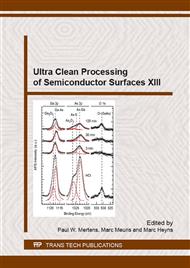p.129
p.136
p.141
p.147
p.152
p.157
p.163
p.168
p.172
Watermark-Free and Efficient Spray Clean on Hydrophobic Surface with Single-Wafer Technology
Abstract:
The interaction of spray-based physical clean and hydrophobic surfaces is studied on a single-wafer technology. A model simulating a rolling water marble on a rotating disk describes accurately the footprint of watermarks, Contrary to its oxide, on a silicon surface the adhesion of particles does not depend on the pH value but on the rotation speed. This newly proposed method, based on the simultaneous combination of spray and liquid dispense is then compared to the standard IPA-based process. Despite the non-usage of solvents, the substrates show similar particles level, defectivity and epi-growth quality.
Info:
Periodical:
Pages:
152-156
Citation:
Online since:
September 2016
Authors:
Keywords:
Price:
Сopyright:
© 2016 Trans Tech Publications Ltd. All Rights Reserved
Share:
Citation:


